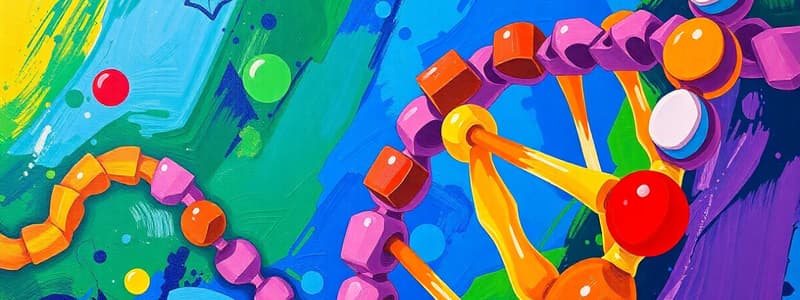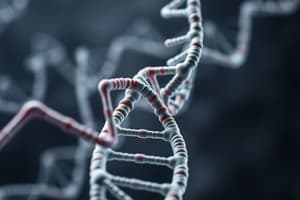Podcast
Questions and Answers
What is formed when a phosphate group is added to a nucleoside?
What is formed when a phosphate group is added to a nucleoside?
- Nucleoprotein
- Nucleotide (correct)
- Amino acid
- Polypeptide
Which type of linkage is responsible for joining adjacent nucleotides in a polynucleotide chain?
Which type of linkage is responsible for joining adjacent nucleotides in a polynucleotide chain?
- Ionic bond
- Peptide bond
- Hydrogen bond
- Phosphodiester linkage (correct)
What is the orientation of the two polynucleotide chains in the DNA double helix?
What is the orientation of the two polynucleotide chains in the DNA double helix?
- Convergent
- Antiparallel (correct)
- Divergent
- Parallel
Which of the following correctly describes the arrangement of components in the DNA double helix?
Which of the following correctly describes the arrangement of components in the DNA double helix?
What characterizes the bonding between bases in the two polynucleotide chains of DNA?
What characterizes the bonding between bases in the two polynucleotide chains of DNA?
Which of the following nucleotides is a ribonucleotide?
Which of the following nucleotides is a ribonucleotide?
The double helix model proposed by Watson and Crick is primarily based on what type of data?
The double helix model proposed by Watson and Crick is primarily based on what type of data?
In the context of nucleotides, what does the term '5' 3' orientation' refer to?
In the context of nucleotides, what does the term '5' 3' orientation' refer to?
What did Hershey and Chase use to label proteins in their experiment?
What did Hershey and Chase use to label proteins in their experiment?
Which component of the virus remained outside the bacteria during the Hershey and Chase experiment?
Which component of the virus remained outside the bacteria during the Hershey and Chase experiment?
In RNA, which nitrogenous base replaces thymine found in DNA?
In RNA, which nitrogenous base replaces thymine found in DNA?
What is the sugar component found in RNA?
What is the sugar component found in RNA?
What do nucleosides consist of?
What do nucleosides consist of?
Which of the following bases are classified as purines?
Which of the following bases are classified as purines?
What is the key difference between deoxyribose and ribose?
What is the key difference between deoxyribose and ribose?
Which of the following statements regarding nucleotides is correct?
Which of the following statements regarding nucleotides is correct?
What is the number of base pairs per complete turn of the DNA helix?
What is the number of base pairs per complete turn of the DNA helix?
Which form of DNA is right-handed, longer, and forms under conditions of high humidity?
Which form of DNA is right-handed, longer, and forms under conditions of high humidity?
How many hydrogen bonds are formed between adenine (A) and thymine (T)?
How many hydrogen bonds are formed between adenine (A) and thymine (T)?
What distinguishes Z-DNA from A-DNA and B-DNA?
What distinguishes Z-DNA from A-DNA and B-DNA?
Which of the following is true regarding the external diameter of the DNA helix?
Which of the following is true regarding the external diameter of the DNA helix?
What was the primary conclusion of Griffith's transformation experiment?
What was the primary conclusion of Griffith's transformation experiment?
In Griffith's experiment, what was the role of the S strain bacteria?
In Griffith's experiment, what was the role of the S strain bacteria?
What was the purpose of Hershey and Chase's experiment?
What was the purpose of Hershey and Chase's experiment?
What characteristic of the R strain bacteria is highlighted in Griffith's work?
What characteristic of the R strain bacteria is highlighted in Griffith's work?
Which bacterium was used by Frederick Griffith to demonstrate the transformation principle?
Which bacterium was used by Frederick Griffith to demonstrate the transformation principle?
What method did Griffith use to kill the S strain bacteria before the experiment?
What method did Griffith use to kill the S strain bacteria before the experiment?
What was the outcome when mice were injected with heat-killed S strain bacteria alone?
What was the outcome when mice were injected with heat-killed S strain bacteria alone?
What virus did Hershey and Chase study to understand genetic material transfer?
What virus did Hershey and Chase study to understand genetic material transfer?
Flashcards are hidden until you start studying
Study Notes
Nucleosides and Nucleotides
- A phosphate group, a five-carbon sugar, and a nitrogen-containing base make up a nucleotide.
- A nucleoside is a sugar and a base combined.
- There are four bases: adenine (A), guanine (G), cytosine (C), and thymine (T) in DNA.
- Adenine (A), guanine (G), cytosine (C), and uracil (U) are the four bases present in RNA.
- Two fused rings make up purines, which include Adenine (A) and guanine (G).
- Cytosine (C), thymine (T), and uracil (U) are pyrimidines, which have a single ring structure.
- The sugar deoxyribose is found in DNA, whereas ribose is found in RNA.
- Deoxyribose and ribose are both pentoses, which are sugars with five carbons.
- Deoxyribose contains one less oxygen than ribose.
DNA double helix
- DNA consists of two polynucleotide chains wound around each other in a right-handed direction.
- The two chains are antiparallel, meaning the 5'-end of one strand is opposite the 3'-end of the other.
- On the outside of the double helix are the sugar phosphate backbones, while the bases are facing the central axis.
- The bases in each of the two polynucleotide chains are connected to each other by hydrogen bonds.
- Adenine (A) bonds with thymine (T) using two hydrogen bonds.
- Guanine (G) binds with cytosine (C) using three hydrogen bonds.
- The two chains are complementary to each other.
- It takes 3.4 nm for one complete (360°) turn of the helix, with 10 base pairs per turn.
- The helix's exterior diameter is 2 nm.
- The major and minor grooves are located between the backbone strands.
Different DNA Forms
- There are three primary forms of DNA: A-DNA, B-DNA, and Z-DNA.
- A-DNA - This form is right-handed, shorter and wider, and contains 11 base pairs per turn (23 Å). It generally appears in high salt concentrations.
- B-DNA - This form is right-handed, longer, thinner, and contains 10 base pairs per turn (34 Å). It is the predominant form found in cells and is what Watson and Crick described initially.
- Z-DNA - This form is left-handed, longer, thinner, and contains about 12 base pairs per turn (46 Å). It is most often found in DNA molecules with alternating G-C sequences.
- 5-Methylcytosine within Z-DNA is associated with gene regulation in eukaryotic cells.
Studying That Suits You
Use AI to generate personalized quizzes and flashcards to suit your learning preferences.




